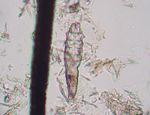Difference between revisions of "Demodex"
| Line 1: | Line 1: | ||
[[Image:Demodex canis.jpg|right|thumb|150px|''Demodex canis'' - Wikimedia Commons]] | [[Image:Demodex canis.jpg|right|thumb|150px|''Demodex canis'' - Wikimedia Commons]] | ||
| − | ''Demodex spp.'' are found on all domestic mammals as well as in humans and are usually a commensal organism. It is a [[Burrowing Mites|burrowing mite]] as opposed to | + | ''Demodex spp.'' are found on all domestic mammals as well as in humans and are usually a commensal organism. It is a [[Burrowing Mites|burrowing mite]] as opposed to a surface mite meaning that it penetrates into the hosts tissue. Each host has a specific species of the ''Demodex'' mite. A clinical infection of ''Demodex spp.'' is termed demodicosis. |
===Identification=== | ===Identification=== | ||
| Line 17: | Line 17: | ||
::This is by far the most commonly seen species of Demodex causing clinical problems. Its host species is the dog and demodicosis is usually a secondary opportunistic pathogen due to other underlying conditions. | ::This is by far the most commonly seen species of Demodex causing clinical problems. Its host species is the dog and demodicosis is usually a secondary opportunistic pathogen due to other underlying conditions. | ||
*''Demodex criceti'' & ''Demodex aurati'' | *''Demodex criceti'' & ''Demodex aurati'' | ||
| − | ::Cause hair loss in Hamsters | + | ::Cause hair loss in Hamsters. |
| − | + | *''Demodex bovis'' | |
| − | + | ::Causes pea shaped nodules in cattle. | |
[[Category:Burrowing_Mites]] | [[Category:Burrowing_Mites]] | ||
[[Category:To_Do_-_NickJ]] | [[Category:To_Do_-_NickJ]] | ||
Revision as of 18:48, 5 July 2010
Demodex spp. are found on all domestic mammals as well as in humans and are usually a commensal organism. It is a burrowing mite as opposed to a surface mite meaning that it penetrates into the hosts tissue. Each host has a specific species of the Demodex mite. A clinical infection of Demodex spp. is termed demodicosis.
Identification
The Demodex species have a distinctive cigar shaped appearance under microscopic examination. They have four pairs of stumpy legs on the anterior portion of the body. This distinctive long and narrow appearance allows them to burrow into and remain inside hair follicles.
Life cycle
Demodex species complete their entire life cycle within the hair follicles and sebaceous glands of a single host. Transmission between hosts occurs by close contact usually these will be commensals of the host from a young age due to maternal transfer to the neonate during suckling. Their life cycle takes 3 weeks to complete.
Eggs
- 20-24 laid at a time into hair follicles.
Larvae
- Hexapod
- 3 larval stages before becoming adult
Important Species
- Demodex canis
- This is by far the most commonly seen species of Demodex causing clinical problems. Its host species is the dog and demodicosis is usually a secondary opportunistic pathogen due to other underlying conditions.
- Demodex criceti & Demodex aurati
- Cause hair loss in Hamsters.
- Demodex bovis
- Causes pea shaped nodules in cattle.
